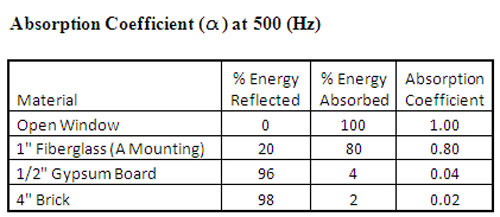Noise Control and Room Acoustics in Building Design
Room acoustics
Sound reflection in a room can be compared to light reflection. Light reflects most brightly from light colored or mirrored finishes. Sound reflects with little energy loss from hard surfaces like concrete or gypsum board. A soft surface such as carpet or curtains (dark surfaces for light) will not reflect as much sound.
Various materials reflect sound at varying degrees and at different frequencies. Concrete will reflect about 99 percent of the sound that hits it, and a 2-inch-thick acoustical panel will reflect 5 percent. The typical 2-inch thick acoustical panel will not be as effective at absorbing lower frequencies versus higher frequencies. Carpet only absorbs high frequencies. Sound absorption is the opposite of sound reflection. A very small amount of sound in higher frequencies is absorbed by air.
Implementing sound absorption strategies can reduce both the noise level by as much as 8-10 dB while also reducing the reverberation time. Properly applied absorptive materials will improve speech intelligibility and the clarity of music. However, too much absorption makes the space too “dead.” Too little absorption makes the space too “live.” The shape and volume of the room are important components along with the amount of sound absorption and where it is located. It should be noted that sound absorption materials, standing alone, do little to “block” noise or reduce sound transmission.
 |
Noise Reduction Coefficient (NRC) represents sound energy absorbed. Provided by Kinetics Noise Control |
Noise reduction coefficient (NRC)
Noise reduction coefficient (NRC) is a single number measure of the amount of sound energy absorbed when striking a particular surface. An NRC of 0.00 indicates very high reflection; an NRC of 1.00 indicates very high absorption. NRC is the arithmetical average rounded to the nearest multiple of 0.05, of the absorption coefficients for the 250, 500, 1000, and 2000 Hz frequencies. The sound absorption coefficients of materials are commonly determined through use of standardized testing procedures, such as ASTM C423.
NRC is most commonly used to rate general acoustical properties of acoustic ceiling tiles, baffles, and banners, office screens, and acoustic wall panels. It is occasionally used to rate floor coverings and construction materials.
Sabin. The unit measure for sound absorption is the Sabin, named after Wallace Clement Sabine (1868-1919) who was a pioneer in architectural acoustics. One Sabin is the sound absorption provided by 1 sq ft of a perfectly absorptive surface whose absorption coefficient is 1.0, such as an open window. Sound goes through the window with no reflected energy back into the space. Many acoustical products have high sound absorption coefficients in various frequencies.
 |
Absorption Coefficient (α) describes ability of material to absorb sound. Provided by Kinetics Noise Control |









